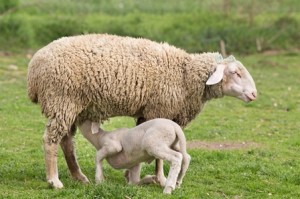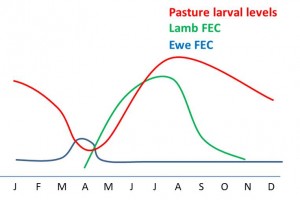Sheep Diseases
Teladorsagia circumcincta

Ewes are significant is the persistence of this parasite due to a phenomena called the ‘Peri-parturitent rise’ (PPR) , in which faecal egg output from the ewes increases around lambing as their immune system is suppressed.
Teladorsagia circumcincta is one of the most economically important gastrointestinal nematode parasites of sheep in cool temperate regions (Venturina et al., 2013). They are abundant on farms in the UK as survey of 118 UK farms carried found T. circumcincta on 100% of the farms (Burgess et al., 2012). There are a number of possible reasons why T. circumcincta is so successful, including their ability of the free-living stages to develop in the lower temperatures of a temperate climate (O’Connor et al., 2006) and the ability of the fourth larval stage to overwinter in the host in a hypobiotic state (Sargison et al., 2007). Under optimal conditions their life cycle takes about 3-4 weeks to complete.
The pathology of T. circumcincta infection (teladorsagiosis) is associated with the immune response to the larvae developing in the abomasal gastric glands damaging the guts ability to digest food. Clinical signs include loss of weight due to a suppressed appetite, dehydration and intermittent diarrhoea.
Ewes act as a significant source of infection for lambs, due to the peri-parturient rise (PPR) also known as the ‘spring rise’. Pasture numbers of L3 increase most during mid-summer onwards, these eggs are from those shed during the PPR (2 weeks prior to lambing – 6 week after) and grazing lambs are most affected in the second half of the summer as pasture larval levels increase (See graph)

This graph illustrates the significance of the eggs deposited onto the pasture by ewes around lambing (PPR). The ewes FEC output will remain low all year round except for at lambing. Pasture larval levels increase from spring onwards due to these deposited eggs, and as a result the infective L3 are ingested by susceptible lambs who will then shed more eggs themselves as infection progresses.
This nematode is sometimes referred to as Ostertagiosis in sheep as it causes similar in pathogenesis to Ostertagia in cattle.
The adult worms survive in the abomasum in low numbers and do little damage unlike Haemonchus spp.
Immunity is acquired upon previous exposure, also unlike Haemonchus spp.
Hypobiosis is important in this disease as it will give rise to Type II disease (similar to Ostertagia ostertagi in cattle).
Type I Teladorsagia Infection
Type 1 Teladorsagia infection caused by the ingestion of large numbers of infective L3 and is typically seen lambs in the late summer as pasture larval levels build up throughout the grazing season.
Clinical signs include watery diarrhoea in lambs, accompanied by dehydration, loss of appetite and failure to gain weight. Developing larvae within the gastric glands of the abomasum cause the these glands to distend and stretch the cellular lining. As the infection progresses, adjacent non-parasitized glands also become affected and their parietal cells replaced by non-functional undifferentiated cells (Jackson and Coop, 2007).
Type II Teladorsagia Infection
A sub-acute or chronic form is called Type II teladorsagiosis similar to type II ostertagiosis in cattle, is seen occasionally in both housed and out-wintered ewes and hogs in late winter / early spring and is caused by the mass emergence of hypobiotic (arrested) larva, which were ingested in autumn as infective L3, and have arrested development as L4s in the gastric glands (Jackson and Coop, 2007). Type II teladorsagiosis is less of a problem in sheep than Type II ostertagiosis is in cattle.
Control and Prevention of Teladorsagiosis
As PPR plays such a vital role in the abundance of this parasite, on farms where PGE is an issue it is often recommended to dose the ewes around lambing to suppress egg output. This strategic treatment is not intended to benefit the ewes but to reduce pasture contamination for this year’s lamb crop. However, SCOPS guidelines recommend to leave a proportion of ewes untreated (e.g. ewes with singles in good condition), as blanket treatment may accelerate the build-up of anthelmintic resistance.
At weaning mature ewes can be used to clean up pasture before putting the lambs in. The PPR should have waned so the ewes should have low worm burdens themselves. They will ingest large numbers of infective T. circumcincta L3 but their immune systems should eliminate them. This strategy will not work for controlling Haemonchus as ewes build up little immunity to this parasite.
Control and prevention of parasitic gastroenteritis relies on an integrated parasite management plan. Full details of the factors influencing disease and control and prevention can be found on the main parasitic gastroenteritis page. The control and prevention section is divided into the various grazing and management strategies which can be combined to form an integrated control plan. The sections covered are:
- Faecal Egg Counts
- Mixed Grazing
- Alternating Stock
- Rotational and Evasive Grazing
- Extensive Grazing and Stocking Density
- Cutting and Reseeding Pasture
- Pasture Composition
- Strategic Anthelmintic Treatments
Anthelmintic resistance is an active concern internationally, and there is a special need to alter control strategies to take account of this. See the anthelmintic resistance section of the main PGE in ruminants page.
Treating Teladorsagiosis
Diagnosis in lambs should be based on clinical signs, season and faecal egg counts. As disease often occurs late summer/ early autumn, observing for clinical signs such as poor weight gain and scours accompanied with regular FECs to monitor worm burden. If egg output reach a determined threshold, treatment may be required.
The most important source of infection for the lamb crop is undoubtedly the PPR increase. Effective strategic anthelmintic therapy of ewes during the fourth month of pregnancy should eliminate most worm burdens at this time, and it is essential to use an anthelmintic that is effective against the arrested larval stages (Jackson and Coop, 2007).
However, the use of the long-acting moxidectin injection injection should be avoided as it has been shown to select for resistant Teladorsagia (Leathwick et al., 2015).
Teladorsagiosis is showing variable levels of resistance to group 1 (Benzimadazoles), group 2 (Levamizole) and group 3 (Macrocyclic Lactones, MLs). If resistance is diagnosed (see below), group 4 (monepantel) or group 5 (derquantel) may be used strategically within SCOPS guidelines. Resistance to monepantel has recently been discovered in New Zealand (Scott et al. 2013) and The Netherlands (Anon. 2014). Farmers should monitor egg burden and perform resistance checks.
The faecal egg count reduction test (FECRT) is the most widely used method to assess the efficacy of anthelmintics including those that undergo metabolism in the host. The FECRT provides an estimation of anthelmintic efficacy by comparing faecal egg counts of animals before and after treatment (Taylor et al., 2002). It has been demonstrated that individual FECRT provide reliable evaluation when egg counts are over 300 eggs/gram and when at least 10 animals have been tested (Cabaret and Berrag, 2004).
Good Practice Based on Current Knowledge
- Regular FECs to monitor worm burden in both ewes around lambing and lambs post-weaning
- Develop and integrate parasite control plan specific to your system using the control measures identified in the PGE in Ruminants page
- Use older stock to ‘clean-up’ pasture before putting the lambs in
- Consider a strategic treatment of ewes around lambing (2 weeks before and up to 6 weeks after) to reduce pasture contamination using anthelmintics which kill arrested larvae, leave a proportion of ewes untreated.
- In high levels of egg outputs from lambs drench with an anthelmintic but carry out a drench check to test the drug efficacy
- Whenever anthelmintics are administered undertake a drench check to ensure the drench has worked
- Every 2 – 3 years carry out a formal FECRT


 American English
American English

Comments are closed.